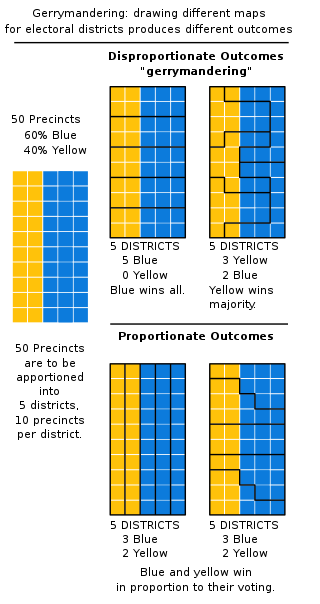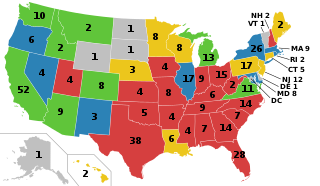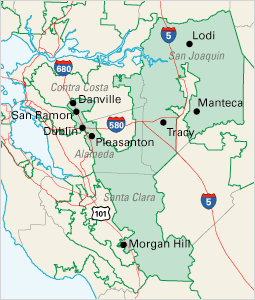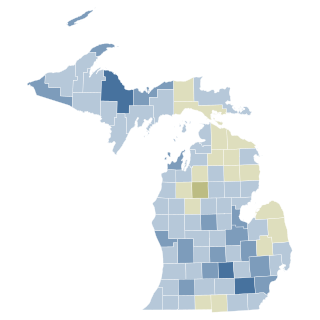
Plurality voting refers to electoral systems in which the candidates in an electoral district who poll more than any other are elected.

In representative electoral systems, gerrymandering is the political manipulation of electoral district boundaries to advantage a party, group, or socioeconomic class within the constituency. The manipulation may involve "cracking" or "packing". Gerrymandering can also be used to protect incumbents. Wayne Dawkins, a professor at Morgan State University, describes it as politicians picking their voters instead of voters picking their politicians.
An electoraldistrict, sometimes called a constituency, riding, or ward, is a subdivision of a larger state created to provide its population with representation in the larger state's legislature. That body, or the state's constitution or a body established for that purpose, determines each district's boundaries and whether each will be represented by a single member or multiple members. Generally, only voters (constituents) who reside within the district are permitted to vote in an election held there. District representatives may be elected by a first-past-the-post system, a proportional representative system, or another voting method. They may be selected by a direct election under universal suffrage, an indirect election, or another form of suffrage.

North Carolina is currently divided into 14 congressional districts, each represented by a member of the United States House of Representatives. After the 2000 census, the number of North Carolina's seats was increased from 12 to 13 due to the state's increase in population. In the 2022 elections, per the 2020 United States census, North Carolina gained one new congressional seat for a total of 14.
In electoral systems, a wasted vote is any vote cast that is not "used" to elect a winner, and so is not represented in the outcome. However, the term is vague and ill-defined, having been used to refer to a wide variety of unrelated concepts and metrics. The precise definition of a wasted vote can have a major impact on the conclusions of an analysis. For example, under the narrowest possible definition of a wasted vote, the single transferable vote (STV) can be considered to waste zero votes. However, if the wasted vote definition is expanded even slightly, it is possible for up to 100% of STV votes to be classified as wasted because STV fails the unanimity criterion; that is, it is possible to elect a legislature that every single voter agrees is worse than some alternative.
Ohio's 3rd congressional district is located entirely in Franklin County and includes most of the city of Columbus. The current district lines were drawn in 2022, following the redistricting based on the 2020 census. It is currently represented by Democrat Joyce Beatty.

South Carolina's 1st congressional district is a coastal congressional district in South Carolina, represented by Republican Nancy Mace since January 3, 2021. She succeeded Democrat Joe Cunningham, having defeated him in the 2020 election. Cunningham was the first Democrat to represent the district since the 1980s.
Vieth v. Jubelirer, 541 U.S. 267 (2004), was a United States Supreme Court ruling that was significant in the area of partisan redistricting and political gerrymandering. The court, in a plurality opinion by Justice Antonin Scalia and joined by Chief Justice William Rehnquist and Justices Sandra Day O'Connor and Clarence Thomas, with Justice Anthony Kennedy concurring in the judgment, upheld the ruling of the District Court in favor of the appellees that the alleged political gerrymandering was not unconstitutional. Subsequent to the ruling, partisan bias in redistricting increased dramatically in the 2010 redistricting round.

Gerrymandering is the practice of setting boundaries of electoral districts to favor specific political interests within legislative bodies, often resulting in districts with convoluted, winding boundaries rather than compact areas. The term "gerrymandering" was coined after a review of Massachusetts's redistricting maps of 1812 set by Governor Elbridge Gerry noted that one of the districts looked like a mythical salamander.

Redistricting in California has historically been highly controversial. Critics have accused legislators of attempting to protect themselves from competition by gerrymandering districts. Conflicts between the governor and the legislature during redistricting often have only been resolved by the courts.
The National Democratic Redistricting Committee (NDRC) is a US organization that focuses on redistricting and is affiliated with the Democratic Party. The organization coordinates campaign strategy, directs fundraising, organizes ballot initiatives and files lawsuits against state redistricting maps. At launch, the organization announced that it intends to support Democratic candidates for local and state offices in order for them to control congressional map drawing in the redistricting cycle following the 2020 United States census.

The 2020 United States redistricting cycle is in progress following the completion of the 2020 United States census. In all fifty states, various bodies are re-drawing state legislative districts. States that are apportioned more than one seat in the United States House of Representatives are also drawing new districts for that legislative body.
Gill v. Whitford, 585 U.S. 48 (2018), was a United States Supreme Court case involving the constitutionality of partisan gerrymandering. Other forms of gerrymandering based on racial or ethnic grounds had been deemed unconstitutional, and while the Supreme Court had identified that extreme partisan gerrymandering could also be unconstitutional, the Court had not agreed on how this could be defined, leaving the question to lower courts to decide. That issue was later resolved in Rucho v. Common Cause, in which the Court decided that partisan gerrymanders presented a nonjusticiable political question.
REDMAP is a project of the Republican State Leadership Committee of the United States to increase Republican control of congressional seats, as well as state legislatures, largely through manipulating electoral district boundaries. The project has made effective use of partisan gerrymandering by relying on previously unavailable mapping software, such as Caliper Corporation's Maptitude to improve the precision with which district lines are strategically drawn. The strategy was focused on swing blue states like Pennsylvania, Ohio, Michigan, North Carolina, and Wisconsin, where there was a Democratic majority, but which they could swing towards Republican with appropriate redistricting. The project was launched in 2010 and estimated to have cost the Republican party around US$30 million.
Benisek v. Lamone, 585 U.S. ____ (2018), and Lamone v. Benisek, 588 U.S. ____ (2019), were a pair of decisions by the Supreme Court of the United States in a case dealing with the topic of partisan gerrymandering arising from the 2011 Democratic party-favored redistricting of Maryland. At the center of the cases was Maryland's 6th district which historically favored Republicans and which was redrawn in 2011 to shift the political majority to become Democratic via vote dilution. Affected voters filed suit, stating that the redistricting violated their right of representation under Article One, Section Two of the U.S. Constitution and freedom of association of the First Amendment.
Rucho v. Common Cause, No. 18-422, 588 U.S. 684 (2019) is a landmark case of the United States Supreme Court concerning partisan gerrymandering. The Court ruled that while partisan gerrymandering may be "incompatible with democratic principles", the federal courts cannot review such allegations, as they present nonjusticiable political questions outside the jurisdiction of these courts.

Redistricting in North Carolina has been a controversial topic due to allegations and admissions of gerrymandering.

Michigan Proposal 18-2 was a ballot initiative approved by voters in Michigan as part of the 2018 United States elections. The proposal was created in preparation of the 2020 United States Census, to move control of redistricting from the state legislature to an independent commission. The commission consists of thirteen members selected randomly by the secretary of state: four affiliated with Democrats, four affiliated with Republicans, and five independents. Any Michigan voter can apply to be a commissioner, as long as they have not been, in the last six years, a politician or lobbyist. Proponents argued that Michigan's current districts are gerrymandered, giving an unfair advantage to the Republican Party. Opponents argued that the process would give the secretary of state too much power over redistricting, and that the people on the commission would be unlikely to understand principles of redistricting. The proposal was approved with 61.28% of the vote.
The 2010 United States redistricting cycle took place following the completion of the 2010 United States census. In all fifty states, various bodies re-drew state legislative districts. States that are apportioned more than one seat in the United States House of Representatives also drew new districts for that legislative body. The resulting new districts were first implemented for the 2011 and 2012 elections.

Nicholas Stephanopoulos is an American legal scholar who is the Kirkland & Ellis Professor of Law at Harvard Law School. His scholarship primarily focuses on election law, constitutional law, and the interplay between law and democracy. Recognized as a leading expert in election law, his work has been cited numerous times by the United States Supreme Court. He has contributed significantly to the study of partisan gerrymandering and is a co-founder of PlanScore, a platform for evaluating district plans. He co-invented the efficiency gap, a metric used to measure potential gerrymandering in electoral systems, which quantifies the fairness of districting by calculating wasted votes.











